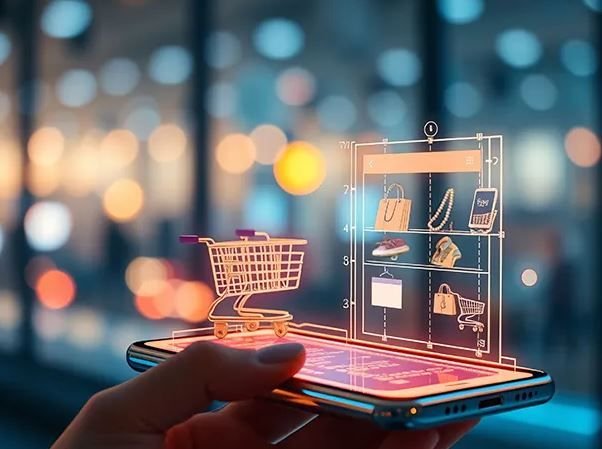Introduction
Remember the old days of online shopping? You’d see a shirt, think, “Yeah, that looks my size,” order it, and then… reality check. Or maybe you bought furniture online, only to realize your new “perfect sofa” blocks half the doorway.
That’s where AR shopping apps come in. Instead of guessing, they let you actually see how products look on you or in your space—through your phone screen. The first time I used one to “try on” sunglasses, my brain went: “Wait… did I just turn my selfie camera into a fitting room?”
Let’s dive into how this works and why it’s becoming a game-changer.
What Exactly Are AR Shopping Apps?
Let’s strip away the jargon.
AR (Augmented Reality): It overlays digital images on the real world using your phone’s camera.
Shopping Apps: Platforms like Amazon, IKEA, Sephora, or even smaller fashion brands now plug AR into their apps.
Put those together, and boom: you’re standing in your living room, pointing your phone at an empty corner, and suddenly there’s a 3D version of a couch sitting there—before you buy it. Or you’re holding your phone to your face, and lipsticks virtually “apply” themselves to show you the shade.
In plain English: AR shopping apps are like test-driving products… without leaving your house.
A Quick Origin Story
2016–2017: Early experiments. IKEA was one of the first big brands to launch AR shopping.
2019: Beauty and fashion apps (like Sephora and L’Oréal) started letting people “try on” makeup and glasses.
2020 onward: COVID lockdowns accelerated adoption—suddenly, virtual try-ons weren’t just fun, they were necessary.
I still remember scrolling through IKEA’s AR app during lockdown, dropping virtual chairs in random corners of my room just for fun. (Half of them didn’t fit, but hey—it saved me from buying a sofa that would have eaten half my floor space.)
How AR Shopping Apps Work (No Geek Speak)
Here’s the gist of it:
1. Camera + AR Tech: Your phone camera scans your room, face, or body.
2. 3D Models: The app has digital models of products (furniture, clothes, makeup, shoes).
3. Overlay: The app places those products “on” you or in your space in real time.
4. Interaction: You can walk around, rotate, zoom, or even “swap colors” instantly.
That’s it. No headsets, no sci-fi equipment—just your phone.
Why People Love AR Shopping Apps
No More Guesswork: Will that shirt fit? Will the couch match the wall? AR answers before you buy.
Confidence Boost: Shoppers feel more sure about purchases. Less “regret clicking.”
Fun Factor: Honestly, it’s entertaining to try out 20 lipsticks in 2 minutes.
Saves Returns: Fewer wrong orders means less hassle (and fewer trips to the post office).
Personalization: Some apps now recommend products based on your “AR try-on” history.
It’s like your shopping cart just got smarter.
The Challenges (Because Nothing’s Perfect)
Accuracy: Sometimes AR lipstick looks flawless on screen but slightly off in real life.
Tech Limits: Older phones may struggle with realistic rendering.
Product Range: Not every brand has 3D models of all items yet.
Privacy Worries: Scanning your face and room raises data security questions.
Internet Speed: A laggy AR preview can ruin the magic.
I’ll be honest: the first time I tried virtual sneakers, they looked like they were floating half an inch above my feet. Cool? Yes. Accurate? Not so much.
Popular AR Shopping Examples
IKEA Place: Virtually place furniture in your room.
Sephora Virtual Artist: Try on makeup shades in real time.
Amazon AR View: See how products look in your home.
Warby Parker: Virtual glasses try-on.
Nike Fit: Scan your foot to get your exact shoe size.
These apps are like tiny magic tricks hidden in your phone.
The Future of AR Shopping
Here’s the kicker: AR shopping isn’t stopping at furniture or makeup.
Clothes That Fit Perfectly: Full-body scanning for custom fits.
Social Shopping: Imagine friends joining your AR session, helping you pick outfits.
Metaverse Integration: AR shopping tied to virtual worlds and avatars.
AI + AR: Smarter recommendations—“That shirt looked great on you in AR; here are three similar styles.”
Personally, I think AR shopping will become as normal as scrolling through photos. In a few years, we’ll wonder how we ever bought things online without “trying them on” first.
Quick FAQ
Q: Do I need special glasses or gear?
A: Nope—most AR shopping works right on your smartphone.
Q: Is it accurate?
A: Pretty close, but not 100%. Lighting, camera quality, and app design all matter.
Q: Is it just for clothes and makeup?
A: No way—furniture, gadgets, shoes, even cars are getting AR previews.
Q: Will AR shopping replace physical stores?
A: Probably not. But it will definitely change how we shop online.
